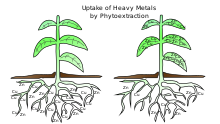
Phytomining, sometimes called agromining,[1] is the concept of extracting heavy metals from the soil using plants.[2] Specifically, phytomining is for the purpose of economic gain.[3] The approach exploits the existence of hyperaccumulators, proteins or compounds secreted by plants to bind certain metal ions. These extracted ores are called bio-ores.[4] The approach has little practical value ("its commercial viability is limited"[1]) because it is slow and inefficient.
History
Phytomining was first proposed in 1983 by Rufus Chaney, a USDA agronomist.[5] He and Alan Baker, a University of Melbourne professor, first tested it in 1996.[5] They, as well as Jay Scott Angle and Yin-Ming Li, filed a patent on the process in 1995 which expired in 2015.[6]
Advantages
Phytomining would in principle cause minimal environmental effects compared to mining.[2] Phytomining could also remove low-grade heavy metals from mine waste.[4]
See also
References
- ^ a b Dang, P.; Li, C. (2022-12-01). "A mini-review of phytomining". International Journal of Environmental Science and Technology. 19 (12): 12825–12838. doi:10.1007/s13762-021-03807-z. ISSN 1735-2630.
- ^ a b Brooks, Robert R; Chambers, Michael F; Nicks, Larry J; Robinson, Brett H (1998-09-01). "Phytomining". Trends in Plant Science. 3 (9): 359–362. doi:10.1016/S1360-1385(98)01283-7. ISSN 1360-1385.
- ^ Linacre, J. Scott Angle and Nicholas A. (2005). Ecological Risks of Novel Environmental Crop Technologies Using Phytoremediation as an Example. Intl Food Policy Res Inst.
- ^ a b "Leaders of the energy transition are calling for a sustainable source of critical metals – is phytomining the answer?". smi.uq.edu.au. 2021-02-11. Retrieved 2023-10-09.
- ^ a b Morse, Ian (2020-02-26). "Down on the Farm That Harvests Metal From Plants". The New York Times. ISSN 0362-4331. Retrieved 2023-10-09.
- ^ US5711784A, Chaney, Rufus L.; Angle, Jay Scott & Baker, Alan J. M. et al., "Method for phytomining of nickel, cobalt and other metals from soil", issued 1998-01-27
